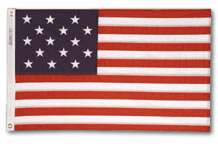Lafayette Chapter
Kentucky Society - Sons of the American Revolution

Last edited 11 January 2024
 |
This Flag became the Official United States Flag on 1 May, 1795 and remained so for 23 years until 1818. The addition of two stars and stripes for the admission of Vermont (the 14th State on 4 March, 1791) and Kentucky (the 15th State on 1 June, 1792) gave this flag its 15 stars and 15 stripes. It is the only official flag of the United States with more than 13 stripes. The Star-Spangled Banner (or the Great Garrison Flag) was the garrison flag that flew over Fort McHenry in Baltimore Harbor during the naval portion of the Battle of Baltimore during the War of 1812. Seeing the flag during the battle inspired Francis Scott Key to write the poem “Defence of Fort McHenry”, which, retitled with the flag’s name of the closing lines of the first stanza and set to the tune “To Anacreon in Heaven”, later became the national anthem of the United States.When Tennessee was added the flag reverted to the original 13 stripes and added the 16th star.
|